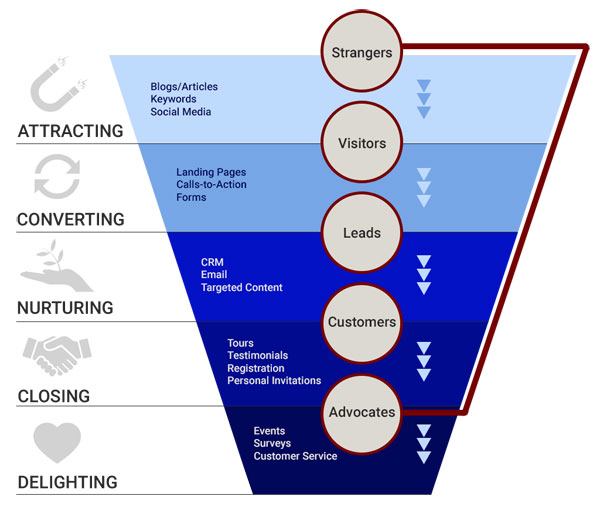For the past 19 years, I’ve watched the gradual change in K–12 education. It is not just how U.S. schools educate students but the parents’ choices in how their children are educated and by whom. The Covid-19 pandemic brought about even more changes that will continue well beyond the life of that particular virus.
Parents are far more aware of their choices, which means schools, whether public or private, have to earn most of the students who enroll. It means that schools need to market themselves to parents and future students.
But marketing is more competitive than it used to be. In the early 1900s there was one radio station, and now there are close to 15,000. In 1945 there were 12 TV stations, and now there are 1,700. A few years back we were bombarded with 3,000 messages per day, and now that number is in excess of 1,500 every second.
This applies to your school as well. There used to be one school in the neighborhood, and only those few families who could afford to send children to a boarding school had any choice about where to send their children.
Now, there are myriad choices, and income or location are not the only deciding factors. School marketing, done right, is a multi-prong approach, and putting together a comprehensive marketing strategy is necessary.

Getting noticed requires a school marketing plan
How do you get your message heard amid this bombardment of information trying to grab our attention? You need to develop and implement a marketing strategy to be heard and found.
To counteract the avalanche of ads targeting us, we’ve learned to block ads, phone calls, and emails. Most of us block ads on our computers, use do-not-call registries on our phones, and record our favorite shows just so we can skip commercials.
I’m not sure how much longer ad agencies are going to be in business since the revenue generated for all these companies paying outrageous amounts of money to create and run these ads can’t be providing the kinds of return on investment that makes it all worthwhile.
But, according to marketing guru Jeff Bullas, inbound marketing generates 54% more leads than advertising, and the cost is 62% lower cost, generating 3x the number of leads.
What is inbound marketing? It is about building trust—showing the value in your school’s expertise through a school marketing plan. The goal is to bring students (or their parents) to you instead of chasing them around or just wringing your hands in despair with continued declining enrollment.

Where does your school excel?
First, you must recognize what parents are looking for in programs and strengths that match your school’s expertise. Determine what areas you would like to market to so you can concentrate your content and keywords on those areas. Start small and only pick a few, to begin with. The following are typical areas of parent interest:
- Preschool
- All-day kindergarten
- Athletic options
- Curriculum
- Teacher experience/skills/training
- Scholarships
- Technology
- STEM / STEAM
- Religious Ed
- At-risk programs
- Transportation
- After-school programs
- Before-school programs
- Cost
- Proximity to home
- Size
- Administration
- Parent involvement
- Special education
- Character education
- Safety
Once you’ve selected the areas of interest for your target audience, you can then begin to write a more formalized plan that will include inbound digital marketing, website content marketing, and keyword emphasis that will improve your website search engine optimization.
Create a school marketing plan
You can develop your school marketing plans by using a formalized template, a spreadsheet, or just a document that outlines your goals and the strategies you want to use. Include realistic deadlines for each step, make assignments if other staff is involved, and assure that every step focuses on your inbound goals, which should be tied to your school’s mission. For a step-by-step worksheet to develop your plan, use our School Inbound Marketing Template.
We recommend:
Start by optimizing your school websites.
If your school website is poorly designed (unintuitive, out-of-date, not mobile-friendly, not website accessible), then begin there. Be sure you have added online reviews, make timely updates, and link to your social media accounts from your school website.
Research your keyword phrases.
There are typically a few keyword phrases (common search terms) that are used to drive people to find your website and your particular educational programs. Knowing your priorities and researching the most effective keywords and phrases will help you produce content that will increase your site traffic and attract the ideal prospects.
In order to be placed at the top of search results, the search engine must rank your news or page as relevant to the search. If you can’t get ranked in the first page results, you are unlikely to be found at all. Learn more at Making SEO Part of Your School Marketing.
Review and rewrite your website content
Your school website will be your primary resource in nearly every aspect of inbound marketing strategies. Each page of your school’s website is an opportunity to write useful and informative content (as well as improve your SEO).
Use keywords throughout your website to highlight the programs and strengths to which you want to attract prospective parents and prospective students. The goal is to draw those ideal website visitors.
Build branded social media channels
If these channels are set up already, but have not been used consistently, consider a refresh to include images, content, and posts focused on your keywords and selected goals. Schedule posts, link to informative content, be engaging, and think strategically. Your social media platforms are an important aspect of your marketing channels.

Start a blog
This is one of the most effective ways to add valuable marketing content to your website and draw potential customers to you. It is also one of the best ways to boost your SEO rankings on a regular schedule. Blogs are also an excellent way to tell your school’s stories in a personal and engaging way.
Oh, and don’t forget to include a call to action (CTA) on each blog post as well, since it is highly likely that your school gets found from one of those captivating blog posts.
Develop content to share
This can be time-consuming, but having at least one useful download that will encourage prospects to share their contact information with you will make it all worthwhile.
If you are focused on just one targeted persona, your content will aim for their priorities and needs. If you have multiple personas, you will develop content targeting each persona’s unique interests. You should tie each piece of content to the overall goals of your school. Learn more about persona development by using our School Inbound Marketing Template.
Download our FREE eBook: How to Create Sensational School Customer Service.
Generate an email nurturing campaign
Your email campaign should be segmented by the targeted audience and their needs. You will eventually produce relevant content for each targeted persona’s interests and needs.
For example, if you were a private Christian school, you might create a quiz called, “Is a Christian school right for your child?” Then offer a video showing a “day in the life…” where visitors can see what a day in your school might include so they can envision their child fitting in. Finally, provide an eBook about “what to look for in a Christ-centered, K–12 curriculum,” that includes a sample course of study highlighting your well-rounded, comprehensive, and challenging curriculum.
This inbound marketing approach works for public schools, independent schools, and vocational schools, with downloads written for their targeted persona interests. A local public school might start with a campaign targeting preschool parents to increase kindergarten enrollment.

School administrators: take notice!
Unfortunately, many public school administrators often do nothing to address their declining enrollment until it affects the programs and classes they can offer or they can’t hire quality staff to teach the classes they must offer.
Because public education is funded through taxes, like any bureaucracy, those in the trenches don’t feel personally responsible for maintaining the requisite income to keep things moving. It’s not their job, and they are not trained to market to parents. They just hope that the federal or state government will increase their per-student funding.
However, at some point, school administrators MUST understand their roles as CEOs in their schools, which includes enrolling students and keeping them. And that, my friends, mean marketing to parents.
Marketing includes keeping current students happy with the services they and their children are receiving, providing excellent customer service to parents, and helping them to feel like valued members of the educational team. Need some help with your school customer service?
And, how do effective school administrators succeed with goals to improve marketing, increase enrollment, and improve branding and reputation? The same way all businesses do it. They put together a marketing plan that helps them accomplish their goals.
It doesn’t have to be complex, and we recommend that you select just one area to focus on at a time. Create content that will provide parents with the information they are seeking and then use social media marketing and your marketing plan to stay in touch.
Use free content, blog articles, and social media highlights to provide proof of your school’s value. Private schools are prime examples of effective public relations. Public school districts would be wise to follow the examples of a private school marketing plan and win those parents’ trust and confidence.
School communications and public relations go hand in hand. By targeting your school community with proven marketing strategies and using SEO to increase your website traffic, both charter schools and public schools will benefit from improved public relations and school communications.
For more information on school marketing:
Inbound marketing for school (Part 1)
Inbound marketing for schools (Part 2)
Posted by Bonnie Leedy, CEO, School Webmasters, LLC.








